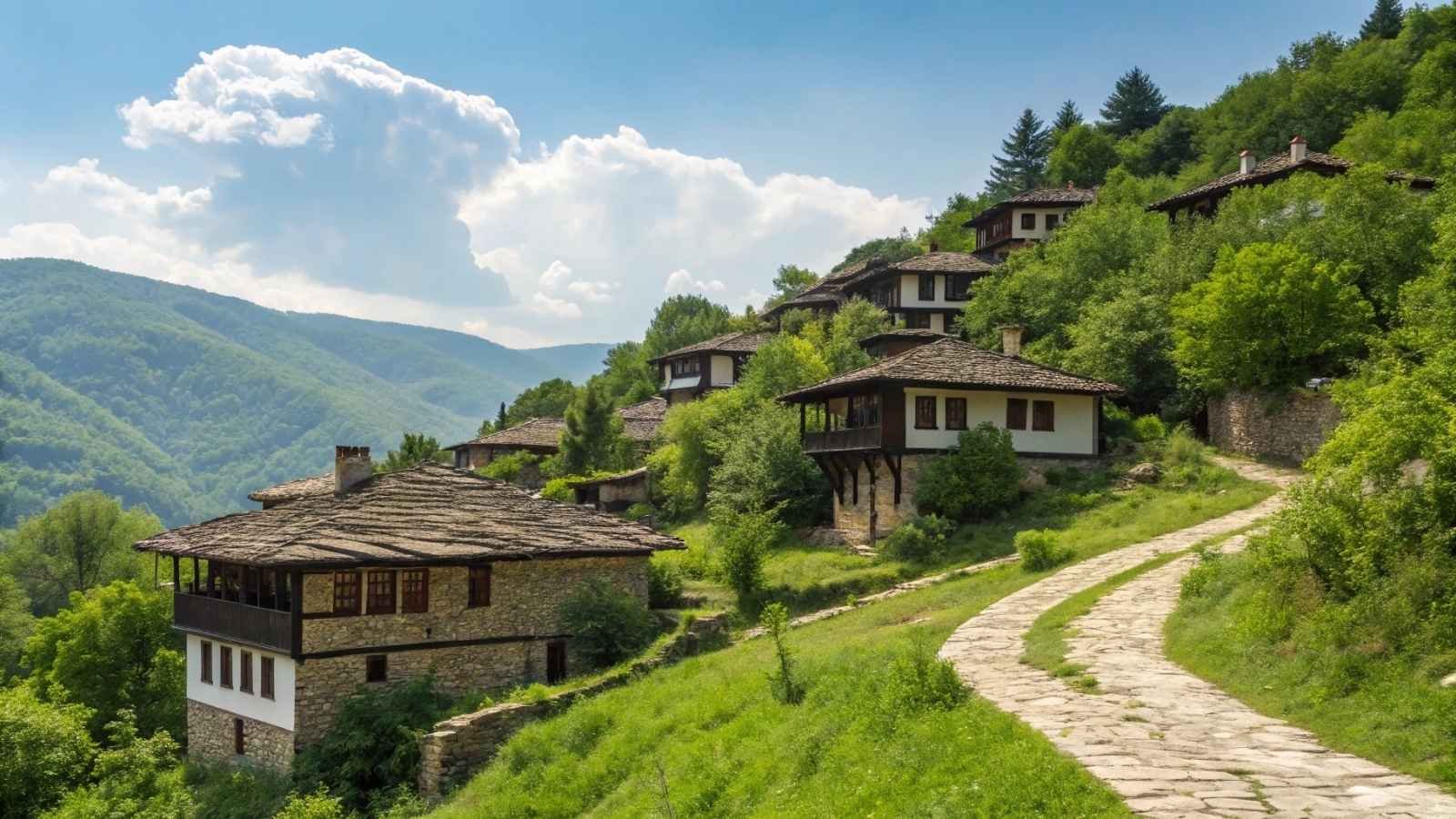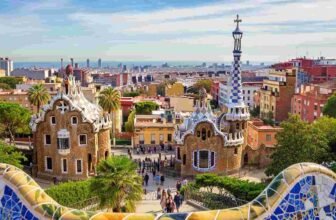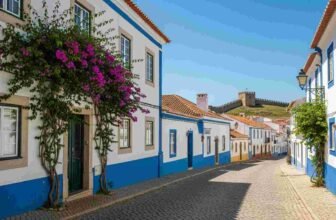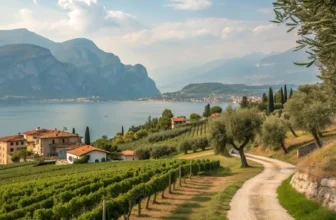
Some places don’t just exist—they whisper. Cobbled lanes that curve like secrets, stone houses hunched under the weight of centuries, valleys where time moves at the speed of drifting smoke.
This is the Balkans as you’ve never seen it: villages so untouched, they feel like dreams the world forgot. No crowds, no postcard racks—just the creak of a wooden gate, the scent of bread in a clay oven, and the quiet thrill of stepping into a story that’s been waiting for you.
If you’ve ever longed to wander where the past still breathes, let’s go. The road is narrow, the tea is hot, and magic doesn’t believe in a rush.
1. Mokra Gora, Serbia – The Storybook Mountain Escape

Nestled in the emerald hills of western Serbia, Mokra Gora feels like a village plucked from a Tolkien novel. The name itself means “Wet Mountain,” and trust me, the misty mornings here make it live up to its title. The star attraction? The Šargan Eight is a historic narrow-gauge railway that twists through forests and over bridges like something out of Harry Potter. Riding it feels like stepping into a living postcard.
What I love most about Mokra Gora is Drvengrad (Timber Town), a whimsical ethno-village built by filmmaker Emir Kusturica. Picture colorful wooden houses, a tiny cinema playing classic films, and streets named after icons like Bruce Lee. It’s quirky, artsy, and utterly charming.** If you’re into slow travel, this is your spot—hiking trails, fresh mountain air, and zero rush.
Best Months to Visit: May–September (lush greenery) or December–February (snowy fairytale vibes).
- Don’t Miss: Riding the Šargan Eight train, and exploring Drvengrad.
- Stay: Wooden guesthouses with mountain views.
- Personal Tip: Try komplet lepinja (a hearty local bread dish) at a village tavern.
2. Kruševo, North Macedonia – The Rebel’s Hidden Gem

Perched at 1,350 meters, Kruševo is North Macedonia’s highest town, and boy, does it feel like floating above the world. The pastel-colored houses stacked on hillsides remind me of Italy’s Cinque Terre—but without the crowds. This place has soul; it was once the heart of a short-lived rebellion against the Ottomans, and that fiery spirit lingers in its cobbled streets.
The Makedonium monument, a futuristic tribute to Macedonian freedom fighters, looks like a surreal art installation. Meanwhile, the old Vlach houses with their ornate woodwork whisper stories of centuries past. Kruševo is also a winter sports secret—its meandering roads turn into sledding paradises when snow hits.
Best Months to Visit: June–September (perfect hiking weather) or January–March (for snow magic).
- Don’t Miss: The sunset from Tošo Proeski’s memorial viewpoint.
- Stay: Family-run guesthouses with homemade rakija (local brandy).
- Personal Tip: Visit during Ilinden (August 2nd) for fiery folk festivals.
3. Bojana, Bulgaria – The Time-Capsule Village by the Black Sea

Just a stone’s throw from bustling Sofia, Bojana feels like medieval Bulgaria frozen in amber. Its claim to fame? The Bojana Church, a UNESCO site with 13th-century frescoes so vivid, they’ll give you chills. The village itself is a patchwork of red-roofed houses, vine-covered walls, and orchards bursting with cherries.
What’s magical here is the contrast: one minute you’re in a quiet lane where babushkas sell honey, and the next you’re hiking Vitosha Mountain’s wildflower meadows. Bojana is a masterclass in slow living—no souvenir shops, just locals tending gardens and kids playing in the square.
Best Months to Visit: April–June (flowers in bloom) or September–October (golden autumn).
- Don’t Miss: The Bojana Church frescoes (book ahead!).
- Stay: Cozy B&Bs with homemade jam breakfasts.
- Personal Tip: Pair your visit with a dip in the hot springs of Bankya.
4. Voskopoja, Albania – The Forgotten Scholar’s Haven

Once an 18th-century intellectual hub with over 20 churches and a printing press, Voskopoja is now a ghostly beauty. The crumbling frescoes of St. Nicholas’ Church are like Albania’s answer to the Sistine Chapel—except you’ll likely have them all to yourself. The village sits in Albania’s “Accursed Mountains”, and the name fits—it’s wild, remote, and hauntingly beautiful.
Today, Voskopoja is shepherd territory. You’ll hear cowbells clinking as flocks wander past Byzantine ruins. The air smells of pine and woodsmoke, and the only “crowds” are curious goats. It’s the Balkans at its most raw and untamed.
Best Months to Visit: July–September (for hiking) or December (snowy solitude).
- Don’t Miss: The Vithkuq trail for panoramic mountain views.
- Stay: Rustic guesthouses with fire-heated rooms.
- Personal Tip: Bring cash—ATMs are a myth here.
5. Štanjel, Slovenia – The Italianate Hilltop Dream

Štanjel is Slovenia’s best-kept secret, a cliffside village that blends Venetian charm with Alpine coziness. The Ferrari Garden (yes, named after a doctor, not the car) is a terraced wonder with killer views over the Karst region. The stone houses glow pink at sunset, and the vibe is dolce far niente—sweet idleness.
This village has survived wars, fires, and time itself. The Carso/Karst wine cellars nearby mean you can sip earthy Teran wine while staring at vineyards that roll into the Adriatic haze. Štanjel is romance without the clichés.
Best Months to Visit: May–October (for wine season) or December (Christmas markets).
- Don’t Miss: The Ferrari Garden’s hidden sculptures.
- Stay: Boutique rooms in restored stone houses.
- Personal Tip: Try pršut (local cured ham) at Gostilna Karst.
6. Lukomir, Bosnia & Herzegovina – The Village Above the Clouds

Perched at 1,500 meters, Lukomir is Bosnia’s highest and most isolated village, where shepherds still live in stone huts with steep roofs designed to shrug off heavy snow. The road here? A heart-in-your-throat dirt track that ends abruptly at the edge of the Rakitnica Canyon. When the fog rolls in, it feels like the edge of the world—just you, a few stray sheep, and the echo of cowbells.
What steals your heart is the ancient stećci (medieval tombstones) scattered like forgotten chess pieces. The villagers, descendants of centuries-old families, greet you with smoky čaj (herbal tea) and stories of Ottoman times. No electricity until the 2000s? No problem. Life here runs on sunrises, sunsets, and the rhythm of the flock.
Best Months to Visit: June–September (hiking paradise) or December–February (for stark, snowy drama).
- Don’t Miss: The hike to Rakitnica Canyon’s viewpoint—sheer drops, zero guardrails.
- Stay: A homestay with local hosts (expect hearty peak meals).
- Personal Tip: Bring a warm jacket—even summer nights are chilly at this altitude.
7. Velo Grablje, Croatia – Hvar’s Forgotten Lavender Village

While tourists mob Hvar’s beaches, Velo Grablje snoozes in the hills, a ghost village reborn. Once abandoned, its crumbling stone houses are now slowly being restored by artists and dreamers. In June, the air turns purple with lavender—the village’s golden-age crop—and the scent is intoxicating. Imagine Provence but with Adriatic light and zero pretension.
The magic here is in the silence. No cars, no crowds, just the buzz of bees and the occasional donkey. The abandoned schoolhouse still has chalkboards scribbled with last-century lessons, and the lone konoba (tavern) serves lamb roasted under a bell. This is Croatia before Instagram discovered it.
Best Months to Visit: June (lavender harvest) or September–October (mild weather).
- Don’t Miss: The Lavender Festival (weekends in June).
- Stay: A restored stone cottage (book early—there are only a handful!).
- Personal Tip: Pair your visit with a hidden beach day at Malo Grablje.
8. Sirogojno, Serbia – The Wool-and-Wood Wonderland

A living museum of 19th-century mountain life, Sirogojno’s log cabins are stacked like gingerbread houses across a green plateau. The village is famous for its hand-knit wool sweaters—chunky, geometric, and so warm they could survive a Siberian winter. Grandmas still spin yarn on porches, and the local artisans’ cooperative is a treasure trove of woven magic.
By day, you’ll forage for wild berries or help bake bread in a creaky old kiln. By night, the sky explodes with stars—no light pollution, just the Milky Way stretched taut. It’s like a folkloric theme park, except everything’s real. Even the rakija (brandy) is homemade, and oh, they’ll insist you try it.
Best Months to Visit: July–August (folk festivals) or December (cozy Christmas markets).
- Don’t Miss: The Open-Air Museum’s workshops (weaving, pottery).
- Stay: A traditional vajat (wooden cabin) with a fireplace.
- Personal Tip: Buy a sweater—they’re heirlooms, not souvenirs.
9. Gjirokastër, Albania – The Stone City of a Thousand Steps

Okay, Gjirokastër is technically a town, but its old quarter feels like a village frozen in Ottoman times. Slate-roofed houses climb the hillside like a stone staircase, earning it the nickname “City of a Thousand Steps.” At the top looms a massive castle—part medieval fortress, part Cold War bunker—with views that’ll make your knees weak.
What’s unforgettable here is the bazaar. No trinket shops, just cobblers hammering leather, coppersmiths shaping pots, and grannies selling mountain tea from folding tables. This is where Albania’s communist past and artisan present collide. Plus, the town birthed dictator Enver Hoxha and writer Ismail Kadare—talk about a complicated legacy.
Best Months to Visit: April–June or September–October (avoid summer’s furnace heat).
- Don’t Miss: The Cold War tunnels under the castle (spooky!).
- Stay: A guesthouse in a UNESCO-listed Ottoman tower.
- Personal Tip: Try qifqi (rice balls with herbs)—a Gjirokastër specialty.
10. Kozjak, Montenegro – The Village That Defied the River

Hidden in the wild Prokletije Mountains, Kozjak is a cluster of stone houses clinging to a cliff above the Cijevna River. To reach it, you cross a wobbly wooden bridge that looks like it’s held together by faith and spiderwebs. The village was abandoned during WWII, but a few families returned, and today it’s a place where time moves to the rhythm of goat bells.
The real star? The watermill, still grinding corn the old way. Locals will invite you for kačamak (a polenta-like dish with cheese) and tales of kayaks (blood feuds)—though now they’re just stories, not warnings. Kozjak is raw, remote, and humbling—a reminder of how stubbornly beautiful life can be.
Best Months to Visit: May–October (the bridge is safer when dry).
- Don’t Miss: The hidden waterfall is a 30-minute hike upstream.
- Stay: A basic mountain hut (don’t expect Wi-Fi).
- Personal Tip: Wear sturdy shoes—the paths are steep and rocky.
11. Leshten, Bulgaria – The Artsy Mountain Hideaway

Picture this: a cluster of 19th-century houses clinging to the slopes of the Rhodope Mountains, their wooden balconies dangling over valleys so deep, you’d swear they’re bottomless. Leshten is the kind of place where time didn’t just slow down—it fell asleep under a wool blanket. Once nearly abandoned, it’s now a haven for artists, writers, and anyone who thinks WiFi is overrated.
What makes Leshten special? The light. At golden hour, the entire village glows like honey, and the silence is so thick, you can hear the wind comb through the grass. The locals? A mix of old-world farmers and bohemian transplants who’ve turned crumbling barns into cozy guesthouses with names like “The House of the Sun.” Want to disconnect? This is your spot.
Best Months to Visit:
- June–September for wildflower hikes and open-air folk concerts.
- December–February for snow-dusted solitude and fireside rakia sessions.
12. Gostuša, Bosnia & Herzegovina – The Village of Stone and Stories

If Lukomir (No. 6) is Bosnia’s rooftop, Gostuša is its secret cellar—a place where the air smells of damp earth, woodsmoke, and centuries-old secrets. The village is a jigsaw puzzle of drystone walls, built without mortar, holding the hillside together like a stubborn old man’s grip. No shops, no cafes, just a handful of families who’ve lived here since the Ottomans ruled.
The magic here is in the details: the way the morning fog slithers between houses, the stećci tombs carved with mysterious symbols, and the sound of a distant flute (probably a shepherd, but it feels like a ghost). This isn’t a place you “visit”—it’s a place you witness, like stumbling into a living museum where the exhibits breathe.
Best Months to Visit:
- July–August for sheep-shearing festivals and wild blueberries.
- October for moody autumn mist and roasted chestnuts.






